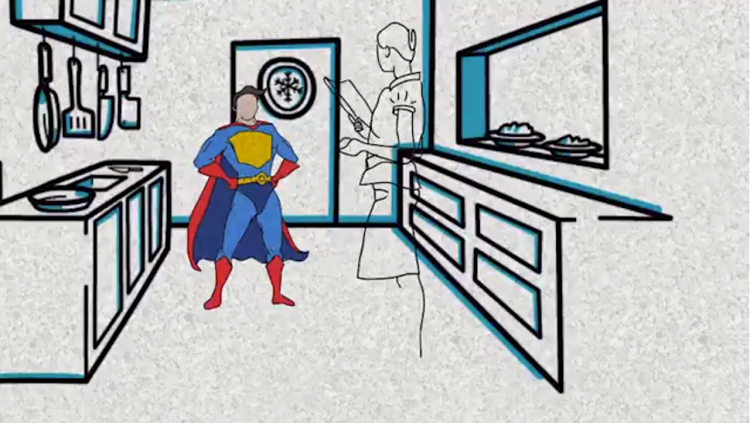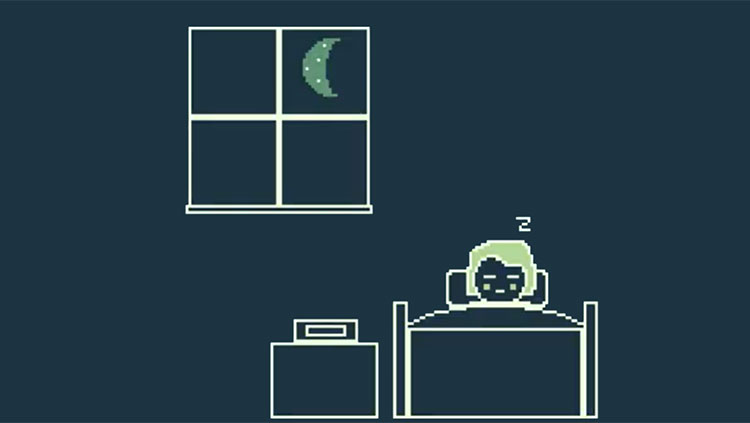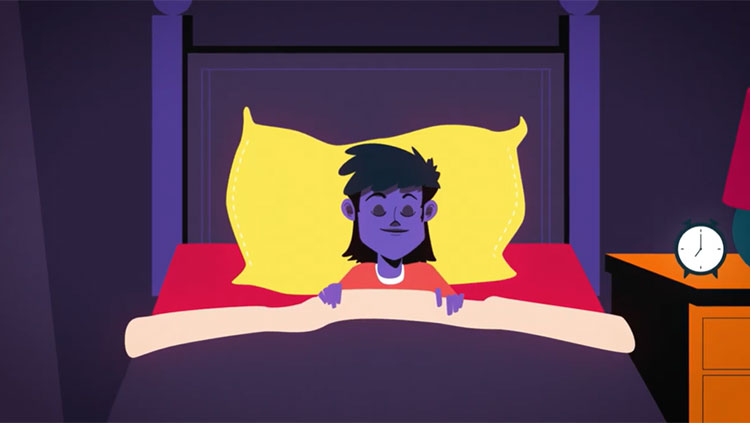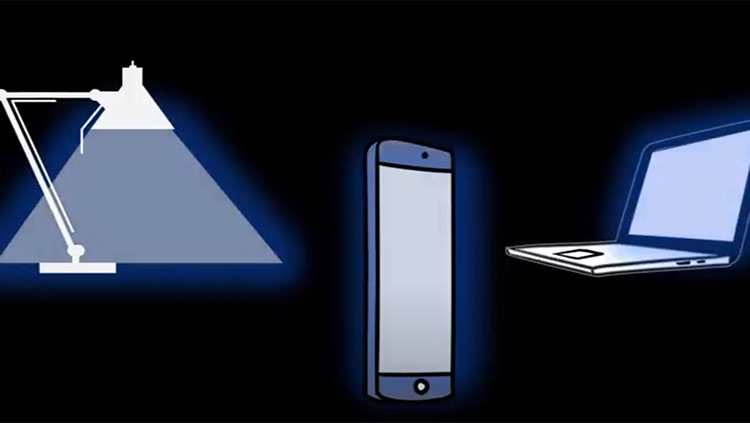The Science of Dreams
- Published29 Apr 2022
- Author Charlotte Stoddart
- Source Knowable Magazine
Freud thought that dreams were the gateway to our unconscious mind. Today, many scientists think the opposite: that the dreaming brain is quite similar to our awake, conscious state. But dreaming is a very personal experience and one that we can’t share — making the phenomenon very difficult to study. We still don’t know for sure why we dream, but in season 2, episode 1 of the Knowable Magazine podcast, we'll hear how psychologists, neuroscientists and philosophers have been trying to answer that question.
Hyperlinks to scientists and papers are included in the transcript.
CONTENT PROVIDED BY
Knowable Magazine is an independent journalistic endeavor from Annual Reviews.
Transcript
What did you dream about last night while you were sleeping?
When you woke up, did you remember your dream? Can you still remember it? How reliable is that memory?
Dreaming is one of the most impractical things a scientist could choose to study. Dreams are a universal part of human experience. But they are by nature subjective. We can’t share them. How can we understand dreams in general then, beyond the vague, untrustworthy recollections that we have of them when we’re awake? How can we study them scientifically and answer the question: Why do we dream?
This is Knowable. And I’m Charlotte Stoddart.
People have been trying to explain dreams for millennia. For a long time, these explanations were rooted in spiritual beings outside of our bodies; dreams were understood as messages from gods or as communications from our ancestors. The scientific study of dreams as something that happens in the brain began with Freud right at the dawn of the 20th century.
In his book “The Interpretation of Dreams,” Freud famously sets out his theory of dreams as the fulfilment of our unconscious wishes. He expands this theory in a later book called “Dream Psychology,” in which he describes the dreams of his patients and explains how to analyze them:
What is common in all these dreams is obvious. They completely satisfy wishes excited during the day which remain unrealized. They are simply and undisguisedly realizations of wishes.
With these books and his other work, Freud founded the field of psychoanalysis. His psychoanalytic approach is often seen as unscientific. But it’s likely that Freud actually wanted to study the dreaming brain in a scientific way; he just didn’t have the tools to do it. As a young researcher at the University of Vienna, Freud spent years studying the nervous system of sea lamprey and eels, publishing several scientific papers on his findings. Freud also studied human nerve cells, using a microscope to see his tissue samples. But a microscope was no use for studying the dreaming brain of live, sleeping human subjects.
Allan Hobson: “I think Freud understood that to really study dreaming, you had to know what was going on in the brain. He just couldn’t do it. I mean, there were no instruments; the technology wasn’t available to study the brain. So he dropped the brain side of the story and devoted himself solely to the psychological side. And of course, that was bold move, but it’s obviously inadequate.”
Psychedelics open a new window on the mechanisms of perception
That’s Allan Hobson, emeritus professor of psychiatry at Harvard Medical School. Hobson studied sleep and the dreaming brain for six decades, right up until his death at the age of 88, a few weeks after he spoke to me. He was able to do what Freud couldn’t, thanks to an invention in Germany in the 1920s.
Hans Berger was a psychiatrist with a particular interest in psychic phenomena. He wanted to find correlations between brain activity and psychic events. And this led him to come up with a way to record electrical activity in the brain. He experimented with inserting silver electrodes under the scalp, and with placing the electrodes on the surface of his patients’ heads, as is done today. Berger’s recordings revealed patterns of electrical activity that looked like waves when transcribed on paper. He called them electroencephalograms, now known simply as EEGs.
Scientists and doctors began using EEGs to document differences in brain wave patterns between people and during different activities. The breakthrough for dreaming came in the 1950s, at the University of Chicago, where Eugene Aserinsky was trying to launch his career as a physiologist. At that time, sleep was thought of as a period when the brain switches off and rests. And in keeping with that, EEG recordings showed slow waves indicating low-level activity in the brain’s cortex. Not much going on, not much to study. But Aserinsky’s supervisor — Nathaniel Kleitman — thought differently and told Aserinsky to focus on researching sleep.
One evening, Aserinsky decided to hook his 8-year-old son up to an EEG machine, attaching electrodes to his skull and the skin around his eyes. While his son slept, Aserinsky watched the brain patterns produced by the machine. At first he saw the slow waves that he expected, a telltale sign of sleep. But at one point he noticed that the pens tracking his son’s eye movements — as well as the ones registering brain activity — were swinging back and forth, recording jerky eye movements and faster brain waves.
Aserinsky went to check on his son, expecting to find him wide awake and looking around. But the boy was still asleep. Aserinsky observed the same kind of brain activity in other sleeping subjects. It was characterized by rapid eye movements and became known as — you guessed it — rapid eye movement or REM sleep. Aserinsky realized that sleepers could have multiple periods of REM sleep during the night and, crucially, that when people were woken up during REM sleep they were more likely to recall vivid dreams.
By 1973, when a review on sleep was published in the Annual Review of Psychology, it was clear that there were at least two different stages of sleep: slow wave sleep that became known as non-REM sleep, and REM sleep, during which the brain is more active:
As data develop on the phenomenology of sleep states, it becomes increasingly clear that sleep is not simply a resting state, waxing and waning near the lower pole of a continuum of vigilance. Instead, sleep appears to be an extremely complex, constantly changing, but cyclic succession of psychophysiological patterns, qualita¬tively rather than quantitatively different from those of waking.
Keep this thought in mind, because at the end of this podcast we’ll return to the idea of sleep — and in particular dreaming — as not so different from our conscious awake state.
So, the invention of EEG showed that the sleeping brain is an active organ, not simply a resting one. Now there was a way to go beyond our unreliable recollections of dreams and actually study the phenomenon of dreaming. Now scientists could monitor the sleeping brain and they knew when during sleep a person was likely to be dreaming. This was a game changer, says sleep researcher Erin Wamsley:
Erin Wamsley: “It was the discovery of EEG that launched this kind of modern — second half of the 20th century — field of dreaming. And so the discovery of rapid eye movement sleep really is what kicked off the modern era, the post-Freud era of dream research. And so that was all about looking for what is the biological sign that someone is dreaming.”
We’ll hear more about Erin’s research shortly. But first, let’s step into a sleep lab.
For 40 years, the sleep lab was the prime way to study dreaming. That’s where Allan Hobson began his investigations of the dreaming brain in the 1960s.
Allan Hobson: “We had a patient room, a subject room, in which the subject was attached to electrodes, and the electrodes went through the wall. And we sat in a room next door and recorded the brain waves, and when the subjects entered REM or another stage that interested us, we’d wake them up and try to figure out what was going on.”
When they woke their subjects up, they asked them for a “dream report.” Dream reports were nothing new; psychologists and psychiatrists had been asking patients to recount their dreams since Freud. But these earlier reports might be made days, weeks or months after the actual dream took place, with patients choosing to relate only the most memorable of their dreams or perhaps being steered towards particular recollections by their interrogator. Hobson wanted to make dream reports more scientific.
Allan Hobson: “I was becoming aware that what was really needed was a much more quantitative approach to a subjective activity, and that’s why I developed the scoring system that I developed.”
Hobson’s scoring system was a way to record and quantify the content of people’s dreams, including the people who showed up in them, the places, plot continuity and so on.
Allan Hobson: “I think what you have to realize is that most people, including scientists, just didn’t do that. To do that is to create a science instead of a speculative psychology.”
Content analysis by researchers such as William Domhoff, whose name we’ll hear again later, showed that although dreams can seem bizarre, mostly they feature people who are known to us, places that are familiar to us and everyday activities that we perform in our waking lives, as well as things that are on our mind. So a tennis player is likely to dream about playing tennis, maybe with a friend or a family member. While a skier will probably not be playing tennis in her dream, but might be rehearsing downhill turns. These findings might not sound groundbreaking, but in the 1960s and ’70s, every discovery was important because so little was known about dreaming. Here’s Ursula Voss, a psychologist who collaborated with Hobson on more recent studies of dreaming.
Ursula Voss: “I admire the most about these early studies that they didn’t really have a strong hypothesis in one or the other direction, so their research was mostly exploratory. No matter what they found, it was important. And so in my view it’s very reliable and very objective research.”
By the late 1970s researchers had a good understanding of what people dream about.
The question of why we dream was more difficult to answer.
Nevertheless, a 1978 review of sleep and dreams did attempt to address this question. The second half, on dreaming, was written by Rosalind Cartwright. As one of the first women to work in this area, she was often called the “queen of dreams.” Officially she was a psychologist who ran a sleep lab at the University of Illinois, and then for many years at Rush University. In the 1978 review, Cartwright begins by lamenting our lack of understanding, despite now having the tools to study dreams:
It is the syntax and grammar of dreams as cognitive behavior, their meaning and function in relation to other types of cognitive activity of sleep and waking, and their place in our understanding of human behavior more generally that has lagged behind.
The trouble with theories about the function of dreams is that they are difficult to test. One theory that caught Cartwright’s attention is that dreams help us to “assimilate anxiety.” A couple of studies had been done on this, and...
The results of none of these studies is strong and convincing in and of themselves, but all lend some support to the hypothesis that when dreaming is intact in normal persons, waking situations which were previously emotion-evoking are faced more directly and handled more calmly…
Cartwright was intrigued and designed her own experiment to test the theory. She found 29 women undergoing divorce and studied them in her sleep lab for six nights. The women were divided into two groups: depressed and not depressed — and compared to a group of happily married women. In 1984, she published her findings in the journal Psychiatry:
The dreams of those divorcing without major mood upset were longer and dealt with a wider time frame than those of the other two groups. They also dealt with marital status issues which were absent in the dreams of the depressed group.
Cartwright concluded that dreams can act as overnight therapy, a night shift designed to help us process difficult emotions.
This idea has been brought up to date by recent studies looking at chemical changes in the brain, as well as studies using magnetic resonance imaging, MRI, to see which areas of the brain are most active at different stages of sleep. The findings from these studies were summarized in a 2014 review called “The Role of Sleep in Emotional Brain Function”:
Neuroimaging studies reveal significant activity increases during REM sleep in emotion-related regions… These changes in functional brain activity are paralleled (and likely governed by) striking alterations in neurochemistry. Perhaps most remarkable is a substantial reduction in levels of noradrenaline during REM sleep…
Noradrenaline, also known as norepinephrine, is one of the body’s “fight or flight” chemicals. It makes us alert, restless, maybe anxious. It prepares us for action. Irregular levels of noradrenaline are associated with PTSD and major depression.
REM sleep may serve a noradrenergic “housekeeping” function, one that reduces and thus restores concentrations of noradrenaline to baseline each day… allowing for optimal wakeful functioning.
If we don’t get enough REM sleep, as is common among people with PTSD, who fear experiencing flashbacks in their dreams, then our noradrenaline levels aren’t reset properly and we may wake up in a hyper-vigilant, restless state.
These are intriguing findings about REM sleep. But it’s difficult to know exactly what role dreaming plays, because although we can record how much REM sleep someone has, or check their noradrenaline levels, we can’t know for sure how much they are dreaming.
Another theory about why we dream is that dreams help us to consolidate memories. This is what Erin Wamsley studies at Furman University in South Carolina.
Erin Wamsley: “Well, we know that when animals — and apparently humans — fall asleep, patterns of brain activity that were first established when we had a recent experience, are then reactivated or replayed in the sleeping brain. For example, in rodent studies, we see that when a rat is moving through a track — like moving through a maze — you can describe their movement through the maze in terms of a sequence of cells firing: Cell 5, Cell 8, Cell 7. And then when the animal falls asleep, we again see: Cell 5, Cell 8, Cell 7. Cell 5, Cell 8, Cell 7 — but played back in a speeded, time-compressed manner. We haven’t seen exactly that in humans, but still, when humans do a learning task in wakefulness, you can measure patterns of brain activity occurring during that task and see that those patterns of brain activity that occurred during the learning task are again present when the human falls asleep.”
We also know that we dream about our experiences — that’s one of the things that the early content analysis studies told us.
Erin Wamsley: “And then our work has actually shown that when you dream of something you learned recently, people who dream about that experience improve their memory more, compared to people who do not report remembering a dream about the experience. So all that put together, I would say the most plausible explanation is that, at least part of the content of dreams is reflecting this memory-related brain activity, right? I can’t say for sure whether dreams are helping your memory, because we don’t know if it’s important that you consciously experience it; it could be just a side effect.”
Even if it’s not just a side effect — and that’s a difficult thing to test — Erin Wamsley doesn’t think that strengthening memories explains the whole function of dreaming. And Hobson agreed that memory processing is probably only part of the explanation.
Besides, the bizarre scenes that can unfold in our dreams, they aren’t like memories, says Antti Revonsuo, a Finnish philosopher and neuroscientist.
Antti Revonsuo: “What we dream about, they are not our memories. It’s always in the present, it’s novel, it’s creative, it’s original experience, rather than a memory.”
So what other theories are there?
How often are you scared in your dreams? Are you running away from something?
Antti Revonsuo thinks that dreams are a way for us to rehearse potentially threatening situations in order to aid our survival. He calls this the threat simulation theory of dreaming.
Antti Revonsuo: “The most universal topics of dreams are like primitive threat simulations, like being chased, being attacked, and also modern types of threats: You lose your wallet, your phone, the elevator doesn’t work, you are late from the plane — and everybody recognizes this. So I started to realize that the data actually points to this direction.”
Content analysis of dreams by Revonsuo’s research group and others backs this up.
Antti Revonsuo: “In the normal population, it’s usually about two-thirds of dream reports that contain at least one threatening event. The number is usually between 65 to 70 percent of dream reports.”
So the threat simulation theory could explain many of our dreams. But what about dreams that aren’t nightmares or even mildly threatening? How does Revonsuo explain those dreams?
Antti Revonsuo: “I ended up proposing together with my colleagues what we call the social simulation theory, and the basic idea there is that the kind of non-threatening dreams, that what we are rehearsing there, is like social perception, social interaction, social bonding. And this is based on what we now know, as well, if we quantify this kind of social content of dreams, there is also a bias for dreams to contain more social events than our waking lives.”
So far we’ve heard that dreams might help us to rehearse social situations or threatening events, that they might be the product of our brain’s memory processing system, and that they might help us to deal with our emotions.
But not all sleep researchers sign up to one of these theories. In fact, some think that dreams have no biological function at all. William Domhoff, who’s been studying dreams for over five decades, proposes that dreaming is just an accidental byproduct of the brain in sleep mode. Could the complex, vivid imaginings that we all experience every night be a mere side effect, an accident of evolution? Some find that hard to buy. As Allan Rechtschaffen, another longtime sleep researcher, put it in a well-known quote: “If sleep does not serve an absolutely vital function, then it is the biggest mistake the evolutionary process has ever made.”
What have we learnt then, from over 60 years of studying dreaming? Is there any agreement on the what, when and why of dreaming?
We’ve learnt that dreams reflect our waking experiences, with the same people, places and concerns popping up in them — even if they’re mixed up.
We now know that we dream a lot more than we once thought, and we dream during non-REM sleep as well as REM sleep. Here’s Erin Wamsley to explain:
Erin Wamsley: “So if you wake people up from rapid eye movement sleep, on average they might remember a dream around 80 percent of trials. And if you wake people up from non-rapid eye movement sleep, like Stage 2, they would maybe remember a dream around 50 percent of trials. It’s a quantitative difference. And the other differences between dreams and the two sleep stages are the same way. Actually, on average, REM dreams are longer and more vivid. And on average, non- REM dreams are shorter and less vivid, but those two distributions are overlapping. So it would be false to say we only have “real” dreams in REM sleep.”
But what progress have we made on the question of why we dream?
Erin Wamsley: “I don’t think there’s a consensus on what dreaming is, why we dream, what we do, what the function of dreaming is, or even if there is a function. But that being said, maybe some hypotheses from the past have now been ruled out by most people, which itself is a form of consensus and progress. So most psychologists and neuroscientists today have abandoned Freudian dream theory. And most neuroscientists and psychologists today view dreaming as having at least some substantial overlap with waking cognition, that some of the brain and mental processes are similar or overlapping between what we see generates thought and imagery and daydreaming in wakefulness, and what we see generates thought, imagery and daydreaming in sleep. Whereas in the past, there had been more a focus on sleep and dreaming are this crazy, mysterious thing that has nothing to do with being awake, and that was very Freud-influenced.”
So to understand dreaming, says Wamsley, we also need to understand how we generate thoughts and images when we’re awake — and that’s a big, complicated task. Undaunted, in his final years, Allan Hobson tried to synthesize everything he’d learnt about dreaming over his long career into a single theory that also accommodated this overlap between dreaming and our waking thoughts.
A dream is an experience of being present in an imaginary world. You might think of it as a virtual-reality world or a simulation of the world created by the brain. Being awake and conscious is also an experience of being a person in the world. Hobson began by proposing that we are all born with a virtual-reality model of the world in our heads. This innate or “genetic” model needs to be fine-tuned to fit the actual world that we live in and experience every day.
Allan Hobson: “I think you remake your model of the world every night in bed. You compare the genetic model with the experiential model, and you make such adjustments as you can. And you do that every single night.”
Hobson thought of this model of the world that we are born with as a prototype of consciousness. In fact, he thought that it’s there even before birth, when REM sleep becomes active in the fetus’s brain. This is the brain’s way of preparing itself for full consciousness. As we gain experience in the world, we refine our model — and that’s what we’re doing when we dream.
Hobson’s theory, which he called the protoconsciousness theory, can incorporate the idea that dreams and memories are linked, and it accommodates Revonsuo’s threat simulation theory of dreaming. So what does Revonsuo make of it?
Antti Revonsuo: “Well, I find the protoconscious theory, I find very, very interesting idea, and I have nothing against it. I think it would be consistent with any other simulation theories, but the problem with that theory is that it’s much harder to test.”
Still, Revonsuo agrees with Hobson that the dreaming brain is a route to understanding consciousness.
Antti Revonsuo: “Dreaming, we can take it as a model system of the basic form of consciousness. So our waking consciousness and dreaming consciousness, they are pretty much the same system, or highly overlapping systems, in the brain. It’s the same system that generates our being in the world experiencing both cases, and therefore to explain dreaming is to explain consciousness and vice versa. But dreaming is a better model system, because it really highlights the subjectivity of the phenomenon. Dreaming is a phenomenon that we cannot share. We can’t invite anybody into our dream world and say, “Yeah, I have these interesting dreams — please come and take a look.” So we can’t share dreams in any kind of empirical way. They are non-transmissible in some very fundamental manner. And that’s the problem with consciousness as well. Consciousness is subjective. And that’s the challenge for science. How can we do science on a phenomenon that is fundamentally experienced only by one person?”
This is a big shift in thinking. For a long time, most people imagined dreams as coming from outside of the dreamer’s own mind — they came from gods or other spiritual beings. Then Freud suggested that dreams are the product of our unconscious mind, writing:
The interpretation of dreams is the royal road to a knowledge of the unconscious activities of the mind.
But for scientists like Hobson and Revonsuo, dreams are the gateway not to our unconscious mind, but to consciousness itself. Revonsuo is happy that we finally seem to have an agreed definition of what dreams are, even if different theories emphasize different functions.
Antti Revonsuo: “We can say that now everybody is happy to say that, yeah, we can define dreaming as a world simulation or a virtual reality, that it takes into account that the idea that being in a dream feels like being in a world, basically. So nobody says that that’s somehow totally wrong. And then, this is just like the form of dreaming, then when we start to discuss the contents of dreaming, then maybe different theories emphasize different contents. And I’m very happy about that development, because this is kind of what I wanted to see — that the field actually moves forward.”
If you enjoyed this show, please share it with your friends, family and colleagues — we’d love to hear your feedback too. Tweet us @KnowableMag, write to us — we’re podcast@knowablemagazine.org — or leave us a review wherever you listen to podcasts. And don’t forget to subscribe so you don’t miss episodes on the search for extrasolar planets, the development of massive particle accelerators and our quest to treat depression.
In this episode you heard from Allan Hobson, Erin Wamsley, Ursula Voss and Antti Revonsuo. The episode also featured quotes from three articles published by Annual Reviews. They are: Harold Williams et al., 1973; Wilse Webb and Rosalind Cartwright, 1978; Andrea Goldstein and Matthew Walker, 2014. You can find links to those papers and others mentioned in this podcast in the show notes on our website: knowablemagazine.org/podcast.
This podcast was produced by Knowable Magazine, a nonprofit publication that seeks to make scientific knowledge accessible to all. Knowable Magazine is an editorially independent initiative from Annual Reviews. Explore more sound science and smart stories at knowablemagazine.org.
I’m Charlotte Stoddart and this has been Knowable.
References
What to Read Next
Also In Sleep
Trending
Popular articles on BrainFacts.org



















